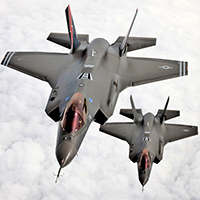Pentagon says nearing fix for F-35 engine

U.S. officials said on Wednesday they were nearing a fix for the engine that powers Lockheed Martin Corp’s (LMT.N) F-35 fighter jet and the United Technologies Corp (UTX.N) unit that makes the engine has agreed to pay to retrofit 156 already delivered.
Pentagon chief arms buyer Frank Kendall told reporters that the U.S. military was close to determining the root cause of a major engine failure in June, and test fixtures were being set up to ensure that Pratt’s proposed corrective actions were acceptable and adequate.
The failure of Pratt & Whitney’s F135 engine grounded the entire F-35 fleet for several weeks this summer and prevented the newest and most advanced U.S. warplane from making its international debut at two UK air shows. Flights have resumed but with certain restrictions on speed and other maneuvers.
“I am getting, over time, more confident that we’ve got our arms around that problem and are solving it,” Kendall said after a defense conference.
Asked about the cost of addressing the issue that destroyed the engine on an Air Force F-35A model at Eglin Air Force Base on June 23, he said, “I don’t think it’s going to be a huge cost. I think it’s a relatively minor cost.”
Air Force Lieutenant General Chris Bogdan, the Pentagon’s F-35 program chief, told the conference that Pratt had agreed to pay for the cost of fixing the 156 engines already delivered once officials agreed to a proposed design change.
Bogdan said the retrofits should be relatively easy and inexpensive to carry out since the engine is built in modules, which will allow mechanics to swap out the entire fan section.
He said Pratt had also agreed to share the cost of any future design changes with the government. Talks about the next two batches of engines should finish soon, he said.
Bogdan lauded Pratt for dedicating its “A team” to solve the engine issue, and said the company also “did everything right” in an issue with faulty titanium supplied by A&P Alloys Inc. He said Pratt would pay to replace a limited amount of titanium affected by the incident.
Pratt and the F-35 program office last week said the metal did not pose a risk to flight safety. Bogdan said there was no link between the engine failure and the titanium supply issue.
Bogdan said the engine incident was a “low to moderate” challenge, but it had put the overall F-35 development program about 30 to 45 days behind schedule.
He said the engine failure was due to the excessive rubbing of one fan blade on an adjacent seal during a certain maneuver that created higher than expected temperatures in the engine.
Bogdan said six of 21 F-35 test planes had been cleared to fly a full flight envelope, and he hoped to get approval for the rest by the end of the month to keep the test program on track.
He said officials next week planned to flight test a complex manuever that could “burn in” the affected seal on newer engines and avoid the excessive rubbing that caused the engine to fail.
Pratt is also due to finish a prototype fan section replacement by the end of the month with pre-set trenches, which could be tested by mid-October. It is working on a design fix for the 3,000-plus F135 engines to be bought in coming decades.